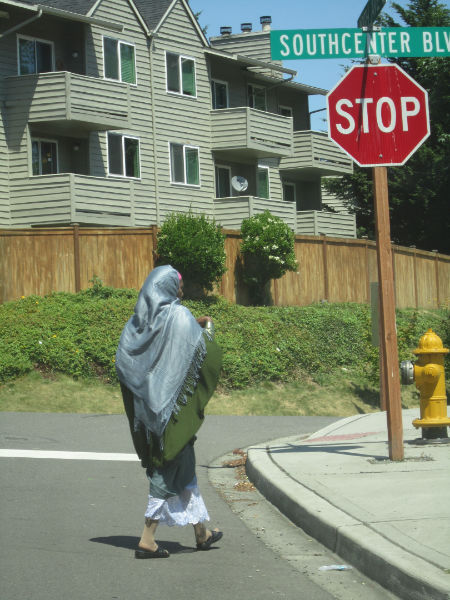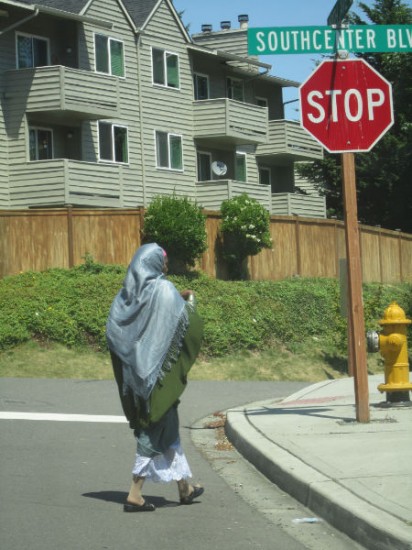Seattle and Portland still rank among the whitest cities in the country. If life doesn’t regularly take you to Tukwila or the Rainier Valley or Bethany or Hillsboro, it’s entirely possible to miss the region’s incredible growth in foreign-born residents.
Occasionally, though, the magnitude of these changes hits you. On my first day as a writing tutor in a local English Language Learning class, a boy handed me a very short story. His fifth-grade class of recent immigrants—Somali girls wearing headscarves, Hispanic kids chattering in Spanish and Mixtec, Burmese and Iraqi students—had been assigned to write something about their life. These aren’t his exact words, but this is how I recall the story that made me realize how ill equipped I was to offer any useful advice:
My mother asked if I was hungry. I said yes. She went to get food and fell down. I shook her. She was dead.
He didn’t offer many details at first, but I later gathered that he arrived as a refugee from Eritrea with what was left of his family. It’s not an uncommon path to Washington State, which typically ranks among top 10 states for resettling refugees as they arrive in the US. That accounts for part of the state’s astonishing rise in foreign-born residents, as do recruitment practices at high-tech companies or research departments looking for international talent.
The number of foreign-born residents in Washington State rose from 322,154 in 1990 to 886,252 in 2010. That’s a nearly 275 percent increase over the last 20 years. In Oregon, during that same time period, the foreign-born population grew from 139,307 to 375,473, only a slightly smaller percentage increase. It’s a remarkable transformation, especially since the demographic changes tend to be concentrated and magnified in particular communities. They’re usually the ones that offer affordable housing and reasonable access to jobs, whether that means coding for Microsoft, doing cancer research, packing fruit, selling gum at the airport, vacuuming planes, or butchering fish.
Mark Ellis, director of the Northwest Census Research Data Center at the University of Washington, calls it the “new geography of immigrants.”
They traditionally moved into run down urban areas and then moved out to the suburban areas, in the “moving out, moving up” traditional American pattern. Now they’re skipping the inner city and going straight to the burbs because central city areas are attractive again. If places like the Central District or Beacon Hill in Seattle were not gentrifying, you’d see higher foreign-born populations but they’ve become expensive. The same process is happening lots of places.
So where are these magnets for international migration? Here are the Washington cities and CDPs (Census-designated places) where at least one in four residents is now foreign-born:
(For a larger view of the chart, click here.)
And here are Oregon cities and CDPs with the highest percentages of foreign-born residents:
(For a larger view of this chart, click here.)
Most places fall into two categories: Agricultural communities in Eastern Washington and Oregon whose foreign-born residents are almost exclusively Hispanic, and diverse suburbs outside of Seattle or Portland where the languages spoken by kids in the public school system might number in the hundreds.
But the patterns in the two states aren’t entirely consistent. To start, Washington has a higher percentage of immigrants than Oregon. According to the 2010 Census (which admittedly isn’t the greatest in capturing an accurate picture of immigrant and refugee populations) foreign-born residents now make up 13 percent of the state’s population. In King County, the number is nearly 19.8 percent. Compared to many other states, Washington’s immigrants are more diverse, with a smaller share of Hispanics dominating the foreign-born population. (Note: Only about 40 percent of the state’s Hispanic residents are foreign-born; many Latinos in King County and elsewhere were born in this country and come from families that have been here for several generations.)
In Oregon, immigrants make up 9.8 percent of the statewide population, 13.7 percent in Multnomah County and 16.8 percent in Washington County. A greater share of Oregon’s foreign-born residents have Hispanic or Latino origins (45 percent) than in Washington (31 percent).
This chart offers more detail about where King County, WA’s foreign-born population comes from:

Source: South King County’s Changing Demographics, Chandler Felt, King County demographer presentation to SeaTac city council
And this chart shows the origins of Oregon’s foreign-born population:

Source: In Search of Opportunity: Foreign-born Residents in Oregon, Portland State University Population Research Center
Given the cultural similarities between Washington and Oregon, why has one been more successful in attracting a larger share of foreign-born residents, and from a greater range of countries?
Some people point to history. Oregon in the mid-1800s was settled by farmers who were largely oriented towards eastern US markets. Washington boomed after the Yukon gold rush in the late 1800s and was more outward-looking towards Alaska and Asia.
Ellis, at the University of Washington, thinks a lot of it boils down to simple economics. In Washington State, there are more jobs, wages tend to be higher, and unemployment levels have been lower. Puget Sound’s growing foreign-born population has also been driven by software and biotech powerhouses poaching talent from China, India, and other foreign countries. (Which is also true of Oregon’s solar and high-tech industries, but perhaps to a lesser extent.) And demand for skilled agricultural workers is so high than asparagus farmers are letting their fields go unpicked for lack of labor. Ellis said:
The economy here is just so much more vibrant—I think that’s a huge part of it. Seattle attracts its own share of people who want to live in a tolerant diverse place but it also has Amazon, it has Boeing and it has Microsoft and when they hire people those people demand all sorts of services. Portland has built a reputation as having all these amenities—light rail and things that hipsters and 20 something and 30 something white college-educated people love—but what if there are no jobs? How long can you attract people?
Washington also has a long history of welcoming refugees, from the first post-Vietnam waves of Southeast Asians to people fleeing persecution after the breakup of the USSR and Yugoslavia to those now seeking refuge from conflicts around the globe. In 2010, Washington ranked #8 in US states providing initial resettlement services for refugees, while Oregon ranked #24.
Although refugees account for a small percentage of immigrants, once an initial group of people from Burma or Ethiopia or the Ukraine establishes a beachhead in a particular community, it tends to balloon. In fact, Washington State ranks second in the US in attracting refugees who initially settled somewhere else but decided to move here because of relatives, word of mouth, state support, mild weather, groceries that offer familiar foods, or news outlets in their native language. As King County demographer Chandler Felt put it:
The refugee population is only about 10 or 20 percent of the foreign-born population in King County, but they kind of set the tone. If you have refugees from a southeast Asian country being helped to arrive here, others tend to follow. So it expands. The refugees have a more important effect than their numbers would indicate.
It also helps explain why some areas of the Portland and Seattle metro areas have become far more diverse while others have stayed nearly as white as ever. Immigrants tend to cluster in neighborhoods at first, establishing grocery stores, travel agencies, churches or mosques, financial services and health practitioners that cater to that community’s customs and everyday needs. At the same time, when I take my daughter to playgrounds near our house in north Seattle, I typically do not run into kids who tell me about the day their mother crumpled in front of the cooking fire and died. Maybe in another 20 years, that picture will look different too.












DayLily
Fascinating article, Jennifer.
At a Common Wealth Literature Conference, in Graz, Austria, that I attended back in 1993, I believe it was Bharati Mukherjee who said, “Multiculturalism is a beautiful word.” I completely agree! 🙂
I believe it’s also important for us here in the U.S. to remember that “white people” are also multicultural.
Together, every culture contributes to this beautiful world.
DayLily
To be clear, what I’m trying to say is that when the media, such as The Seattle Times, brands a *culturally diverse* group of people by the color of their skin (i.e., “white”), we tend to forget that, unless we are Native American Indians, we are *all* ethnic immigrants here.
I believe that America is a place of blended cultures that should be celebrated and not parsed apart by people’s skin color. Multiculturalism is an “all inclusive” word and not a self-conscious word.
Sightline, this is an interesting study, to be sure. But, it just seems like, in the 21st century, the cultural dialogue should be so much further along than this in America.
I’m just sayin’.
kshive
This is a fascinating piece. I just have one quibble which may come from a different perspective than your other commenter thus far. In your lead sentence you say: “Seattle and Portland still rank among the whitest cities in the country… it’s entirely possible to miss the region’s incredible growth in foreign-born residents.”
I’m afraid that this statement makes an unfair conflation of race and country of birth (a mistake that is all too common in journalism and politics). This statement seems to imply that “foreign born” means “non-white” (which later in the article you point our is not true in discussing immigration from the former Soviet Union and Europe). More disturbing is the implication that that any and all white folks one might see are – as indicated by their race – born in the US (or not “foreign born”). The implication of this assumption is that the US is a White Nation/ to be ‘American’ is to be white (not true, of course).
I realize this statement was meant to introduce the fact that these research findings may be surprising to many residents of Northwest cities, especially the differences between Oregon and Washington, but I think it is always helpful to be explicit up front about the terms used and topics of investigation (e.g. differences between race, ethnicity, and immigration status, country of birth, etc.).
Thanks for again for writing on this topic. It is definitely an interesting comparison.
DayLily
Hi kshive,
Thanks so much for contributing to this discussion. I believe you and I share similar perspectives; though, perhaps, you express yourself a bit more clearly than I do!
Just wanted to say that I, too, think it’s always helpful to define the terms used, for clarity’s sake.
In which case, from my own multicultural perspective, I define “race,” in this instance, as the “human race.”
And I define “ethnic” along the same lines as dictionary.com does. The various dictionary.com entries seem to use “ethnic” and “race” as synonyms; which is what I was trying to do when I referred to all of us Non-Native American Indians as “ethnic immigrants.”
DayLily
I.e., the journalistic way is usually to refer to immigrants as both racial *and* ethnic immigrants.
DayLily
…And because there are a lot of logicians who read this weblog (who help keep poetic scientists like me, in line), for the sake of extreme logical clarity I see I might need to make it explicitly clear that I am in no way implying that Native American Indians are not part of the human race since I am using “race” in two different ways here.